Occurrence of Microplastics in River Water in Southern Thailand
Abstract
1. Introduction
2. Materials and Methods
2.1. Study Area
2.2. Sample Collection and Storage
2.3. Microplastic Extraction and Identification
2.4. Contamination Prevention
2.5. Data Analysis
3. Result and Discussion
3.1. Abundance and Distribution of Microplastics in River
3.2. Shape, Size, and Color of Microplastics
3.3. Polymer Types
3.4. Comparison of Abundance of MPs Worldwide
4. Conclusions
Author Contributions
Funding
Institutional Review Board Statement
Informed Consent Statement
Data Availability Statement
Conflicts of Interest
References
- Drummond, J.D.; Schneidewind, U.; Li, A.; Hoellein, T.J.; Krause, S.; Packman, A.I. Microplastic accumulation in riverbed sediment via hyporheic exchange from headwaters to mainstems. Sci. Adv. 2022, 8, eabi9305. [Google Scholar] [CrossRef] [PubMed]
- Pradit, S.; Noppradit, P.; Sengloyluan, K.; Nitiratsuwan, T.; Chuan, O.M.; Towatana, P. Low Occurrence of Microplastic Contamination in Anchovies, a Transboundary Species, in Thai Waters. ScienceAsia 2022, 48, 2–8. [Google Scholar] [CrossRef]
- Munyaneza, J.; Jia, Q.; Qaraah, F.A.; Hossain, M.F.; Wu, C.; Zhen, H.; Xiu, G. A review of atmospheric microplastics pollution: In-depth sighting of sources, analytical methods, physiognomies, transport and risks. Sci. Total Environ. 2022, 822, 153339. [Google Scholar] [CrossRef] [PubMed]
- Hidalgo-Ruz, V.; Gutow, L.; Thompson, R.C.; Thiel, M. Microplastics in the marine environment: A review of the methods used for identification and quantification. Environ. Sci. Technol. 2012, 46, 3060–3075. [Google Scholar] [CrossRef] [PubMed]
- Cole, M.; Lindeque, P.; Halsband, C.; Galloway, T.S. Microplastics as contaminants in the marine environment: A review. Mar. Pollut. Bull. 2011, 62, 2588–2597. [Google Scholar] [CrossRef]
- Kershaw, P. Sources, Fate and Effects of Microplastics in the Marine Environment: A Global Assessment 2015; International Maritime Organization: London, UK, 2015. [Google Scholar]
- Thompson, R.C.; Olsen, Y.; Michell, R.P.; Davis, A.; Rowland, S.J.; John, A.W.G.; McGonigle, D.; Russel, A.E. Lost at Sea: Where Is All the Plastic? Science 2004, 304, 838. [Google Scholar] [CrossRef]
- Azad, S.M.O.; Towatana, P.; Pradit, S.; Patricia, B.G.; Hue, H.T. Ingestion of microplastics by some commercial fishes in the lower Gulf of Thailand: A preliminary approach to ocean conservation. Int. J. Agric. Technol. 2018, 14, 1017–1032. [Google Scholar]
- Guzzetti, E.; Sureda, A.; Tejada, S.; Faggio, C. Microplastic in marine organism: Environmental and toxicological effects. Environ. Toxicol. Pharmacol. 2018, 64, 164–171. [Google Scholar] [CrossRef]
- U.S. Pollution Control Department Office. Pollution Control Department: Wastewater Management Guide for Domestic Wastewater; U.S. Pollution Control Department Office: Bangkok, Thailand, 2012. [Google Scholar]
- Rocha-Santos, T.; Duarte, A.C. A critical overview of the analytical approaches to the occurrence, the fate and the behavior of microplastics in the environment. TrAC Trends Anal. Chem. 2015, 65, 47–53. [Google Scholar] [CrossRef]
- Pradit, S.; Noppradit, P.; Goh, B.P.; Sornplang, K.; Ong, M.C.; Towatana, P. Occurrence of microplastics and trace metals in fish and shrimp from Songkhla Lake, Thailand during the COVID-19 pandemic. Appl. Ecol. Environ. Res. 2021, 19, 1085–1106. [Google Scholar] [CrossRef]
- Boontanon, S.K.; Oo, P.Z.; Boontanon, N.; Tanaka, S.; Shigeo, F. Abundance and distribution of suspended microplastics in the surface water of Chao Phraya River estuary. Thai Environ. Eng. J. 2020, 34, 57–66. [Google Scholar]
- Moore, C.J. Synthetic polymers in the marine environment: A rapidly increasing, long-term threat. Environ. Res. 2008, 108, 131–139. [Google Scholar] [CrossRef]
- Cole, M.; Lindeque, P.; Fileman, E.; Halsband, C.; Goodhead, R.; Moger, J.; Galloway, T.S. Microplastic ingestion by zooplankton. Environ. Sci. Technol. 2013, 47, 6646–6655. [Google Scholar] [CrossRef]
- Nadal, M.A.; Alomar, C.; Deudero, S. High levels of microplastic ingestion by the semipelagic fish bogue Boops boops (L.) around the Balearic Islands. Environ. Pollut. 2016, 214, 517–523. [Google Scholar] [CrossRef]
- Claessens, M.; Meester, S.D.; Landuyt, L.V.; Clerck, K.D.; Janssen, C.R. Occurrence and distribution of microplastics in marine sediments along the Belgian coast. Mar. Pollut. Bull. 2011, 61, 2199–2204. [Google Scholar] [CrossRef]
- Chinfak, N.; Sompongchaiyakul, P.; Charoenpong, C.; Shi, H.; Yeemin, T.; Zhang, J. Abundance, composition, and fate of microplastics in water, sediment, and shellfish in the Tapi-Phumduang River system and Bandon Bay, Thailand. Sci. Total Environ. 2021, 781, 146700. [Google Scholar] [CrossRef]
- Marine and Coastal Resources Knowledge Center. Biodiversity, Songkhla Lake Area. Available online: https://km.dmcr.go.th/c_218/d_2563 (accessed on 25 September 2022).
- Hongnak, P. The Process of Integrating Other Subjects into the Rug Khlong U-Taphao Subject for Mathayomsulsa 4 Students: A Case Study of Patongprathankiriwat School, Tumbon Patong, Amphoe Hat Yai, Changwat Songkla. Master’s Thesis, Prince of Songkla University, Hat Yai, Thailand, 2005. [Google Scholar]
- Masura, J.; Baker, J.; Foster, G.; Arthur, C. Laboratory methods for the analysis of microplastics in the marine environment: Recommendation for quantifying synthetic particles in waters and sediments. NOAA Technical Memorandum NOS-OR&R-48, 2015. Available online: https://marinedebris.noaa.gov/sites/default/files/publications-files/noaa_microplastics_methods_manual.pdf (accessed on 1 November 2022).
- Feiyang, X.; Yao, Q.; Zhang, J.; Wang, D. Effects of Seasonal Variation and Resuspension on Microplastics in River Sediments. Environ. Pollut. 2021, 286, 117403. [Google Scholar] [CrossRef]
- Fitzenreiter, K.; Mao, M.; Xia, M. Characteristics of Surface Currents in a Shallow Lagoon–Inlet–Coastal Ocean System Revealed by Surface Drifter Observations. Estuaries Coasts 2022, 45, 2327–2344. [Google Scholar] [CrossRef]
- Zhang, L.; Liu, J.; Xie, Y.; Zhong, S.; Yang, B.; Lu, D.; Zhong, Q. Distribution of Microplastics in Surface Water and Sediments of Qin River in Beibu Gulf, China. Sci. Total Environ. 2020, 708, 135176. [Google Scholar] [CrossRef]
- Klemchuck, P.P. Degradable plastics: A critical review. Polym. Degrad. Stab. 1990, 27, 183–202. [Google Scholar] [CrossRef]
- Yang, L.; Qiao, F.; Lei, K.; Li, H.; Kang, Y.; Cui, S.; An, L. Microfiber release from different fabrics during washing. Environ. Pollut. 2019, 249, 136–143. [Google Scholar] [CrossRef] [PubMed]
- Carbery, M.; Herb, F.; Reynes, J.; Pham, C.K.; Fong, W.K.; Lehner, R. How Small Is the Big Problem? Small Microplastics < 300 µm Abundant in Marine Surface Waters of the Great Barrier Reef Marine Park. Mar. Pollut. Bull. 2022, 184, 114179. [Google Scholar] [CrossRef]
- Huang, D.; Tao, J.; Cheng, M.; Deng, R.; Chen, S.; Yin, L.; Li, R. Microplastics and nanoplastics in the environment: Macroscopic transport and effects on creatures. J. Hazard. Mater. 2021, 407, 124399. [Google Scholar] [CrossRef] [PubMed]
- Naqash, N.; Prakash, S.; Kapoor, D.; Singh, R. Interaction of Freshwater Microplastics with Biota and Heavy Metals: A Review. Environ. Chem. Lett. 2020, 18, 1813–1824. [Google Scholar] [CrossRef]
- Zhou, Y.; Liu, X.; Wang, J. Characterization of Microplastics and the Association of Heavy Metals with Microplastics in Suburban Soil of Central China. Sci. Total Environ. 2019, 694, 133798. [Google Scholar] [CrossRef] [PubMed]
- Hue, H.; Dong, L.; Hien, T.; Nguyen, T.; Pradit, S. Assessment of microplastics contamination in commericial clams in the coastal zone of vietnam. Appl. Ecol. Environ. Res. 2021, 19, 4977–4991. [Google Scholar] [CrossRef]
- Goh, P.B.; Pradit, S.; Towatana, P.; Khokkiatiwong, S.; Kongket, B.; Moh, J.H.Z. Microplastic Abundance in Blood Cockles and Shrimps from Fishery Market, Songkhla Province, Southern Thailand (Kelimpahan Mikroplastik Dalam Kerang Darah Dan Udang Dari Pasar Ikan, Wilayah Songkhla, Selatan Thailand). Sains Malays. 2021, 50, 2899–2911. [Google Scholar] [CrossRef]
- Stolte, A.; Forster, S.; Gerdts, G.; Schubert, H. Microplastic concentrations in beach sediments along the German Baltic coast. Mar. Pollut. Bull. 2015, 99, 216–229. [Google Scholar] [CrossRef]
- Ory, N.; Chagnon, C.; Felix, F.; Fernández, C.; Ferreira, J.L.; Gallardo, C. Low prevalence of microplastic contamination in planktivorous fish species from the Southeast Pacific Ocean. Mar. Pollut. Bull. 2018, 127, 211–216. [Google Scholar] [CrossRef]
- Hossain, M.S.; Rahman, M.S.; Uddin, M.N.; Sharifuzzaman, S.M.; Chowdhury, S.R.; Sarker, S. Microplastic contamination in Penaeid shrimp from the Northern Bay of Bengal. Chemosphere 2020, 238, 124688. [Google Scholar] [CrossRef]
- Eamrat, R.; Taweesan, A.; Pussayanavin, T. Assessment of Microplastics Distribution and Related Water Quality in an Urban Canal, Thailand. Pollution 2022, 8, 1172–1184. [Google Scholar]
- Ounjaia, K.; Boontanon, S.K.; Piyaviriyakul, P.; Tanakab, S.; Fujii, S. Assessment of microplastic contamination in the urban lower Chao Phraya River of Bangkok city, Thailand. Water Health 2022, 20, 1243. [Google Scholar] [CrossRef]
- Tuan, A.T.; Babel, S.; Haarstrick, A. Microplastics Contamination in a High Population Density Area of the Chao Phraya River, Bangkok. Eng. J. Eng. Technol. Sci. 2020, 52, 534–545. [Google Scholar]
- Hossain, M.J.; AftabUddin, S.; Akhter, F.; Nusrat, N.; Rahaman, A.; Sikder, M.N.A.; Monwar, M.M.; Chowdhury, M.S.N.; Jiang, S.; Shi, H.; et al. Surface water, sediment, and biota: The first multi-compartment analysis of microplastics in the Karnafully river, Bangladesh. Mar. Pollut. Bull. 2022, 180, 113820. [Google Scholar] [CrossRef]
- Hwi, T.Y.; Ibrahim, Y.S.; Khalik, W.M.A.W.M. Microplastic Abundance, Distribution, and Composition in Sungai Dungun, Terengganu, Malaysia. Sains Malays. 2020, 49, 1479–1490. [Google Scholar]
- Ebere, E.C.; Wirnkor, V.A.; Ngozi, V.E.; Chukwuemeka, I.S. Macrodebris and microplastics pollution in Nigeria: First report on abundance, distribution and composition. Environ. Anal. Health Toxicol. 2019, 34, 2019012. [Google Scholar] [CrossRef]
- Ding, L.; Mao, R.F.; Guo, X.; Yang, X.; Zhang, Q.; Yang, C. Microplastics in surface waters and sediments of the Wei River, in the northwest of China. Sci. Total Environ. 2019, 667, 427–434. [Google Scholar] [CrossRef]
- Eo, S.; Hong, S.H.; Song, Y.K.; Han, G.M.; Shim, W.J. Spatiotemporal distribution and annual load of microplastics in the Nakdong River, South Korea. Water Res. 2019, 160, 228–237. [Google Scholar] [CrossRef]
- Timmers, M.A.; Kistner, C.A.; Donohue, M.J. Marine Debris of the Northwestern Hawaiian Islands: Ghost Net Identification; U.S. Department of Commerce, National Oceanic and Atmospheric Administration, National Sea Grant College Program: Silver Spring, MD, USA, 2005. [Google Scholar]
- Jualaong, S.; Pransilpa, M.; Pradit, S.; Towatana, P. Type and Distribution of Microplastics in Beach Sediment along the Coast of the Eastern Gulf of Thailand. J. Mar. Sci. Eng. 2021, 9, 1405. [Google Scholar] [CrossRef]
- Singh, N.; Mondal, A.; Bagri, A.; Tiwari, E.; Khandelwal, N.; Monikh, F.A.; Darbha, G.K. Characteristics and spatial distribution of microplastics in the lower Ganga River water and sediment. Mar. Pollut. Bull. 2021, 163, 111960. [Google Scholar] [CrossRef]
- Tien, C.J.; Wang, Z.X.; Chen, C.S. Microplastics in water, sediment and fish from the Fengshan River system: Relationship to aquatic factors and accumulation of polycyclic aromatic hydrocarbons by fish. Environ. Pollut. 2020, 265, 114962. [Google Scholar] [CrossRef] [PubMed]
- Miller, R.Z.; Watts, A.J.R.; Winslow, B.O.; Galloway, T.S.; Barrows, A.P.W. Mountains to the sea: River study of plastic and non-plastic microfiber pollution in the northeast USA. Mar. Pollut. Bull. 2017, 124, 245–251. [Google Scholar] [CrossRef] [PubMed]
- Xiong, X.; Wu, C.; Elser, J.J.; Mei, Z.; Hao, Y. Occurrence and fate of microplastic debris in middle and lower reaches of the Yangtze River—From inland to the sea. Sci. Total Environ. 2019, 659, 66–73. [Google Scholar] [CrossRef] [PubMed]
- Jiang, C.; Yin, L.; Li, Z.; Wen, X.; Luo, X.; Hu, S.; Yang, H.; Long, Y.; Deng, B.; Huang, L.; et al. Microplastic pollution in the rivers of the Tibet Plateau. Environ. Pollut. 2019, 249, 91–98. [Google Scholar] [CrossRef]
- Scircle, A.; Cizdziel, J.V.; Missling, K.; Li, L.; Vianello, A. Single-pot method for the collection and preparation of natural water for microplastic analyses: Microplastics in the Mississippi River system during and after historic flooding. Environ. Toxicol. Chem. 2020, 39, 986–995. [Google Scholar] [CrossRef]
- Alam, F.C.; Sembiring, E.; Muntalif, B.S.; Suendo, V. Microplastic distribution in surface water and sediment river around slum and industrial area (case study: Ciwalengke River, Majalaya district, Indonesia). Chemosphere 2019, 224, 637–645. [Google Scholar] [CrossRef]
- Schmidt, L.K.; Bochow, M.; Imhof, H.K.; Oswald, S.E. Multi-temporal surveys for microplastic particles enabled by a novel and fast application of SWIR imaging spectroscopy—study of an urban watercourse traversing the city of Berlin, Germany. Environ. Pollut. 2018, 239, 579–589. [Google Scholar] [CrossRef]
- Li, J.; Ouyang, Z.; Liu, P.; Zhao, X.; Wu, R.; Zhang, C.; Li, C.; Li, Y.; Guo, X. Distribution and characteristics of microplastics in the basin of Chishui River in Renhuai, China. Sci. Total Environ. 2021, 773, 145591. [Google Scholar] [CrossRef]
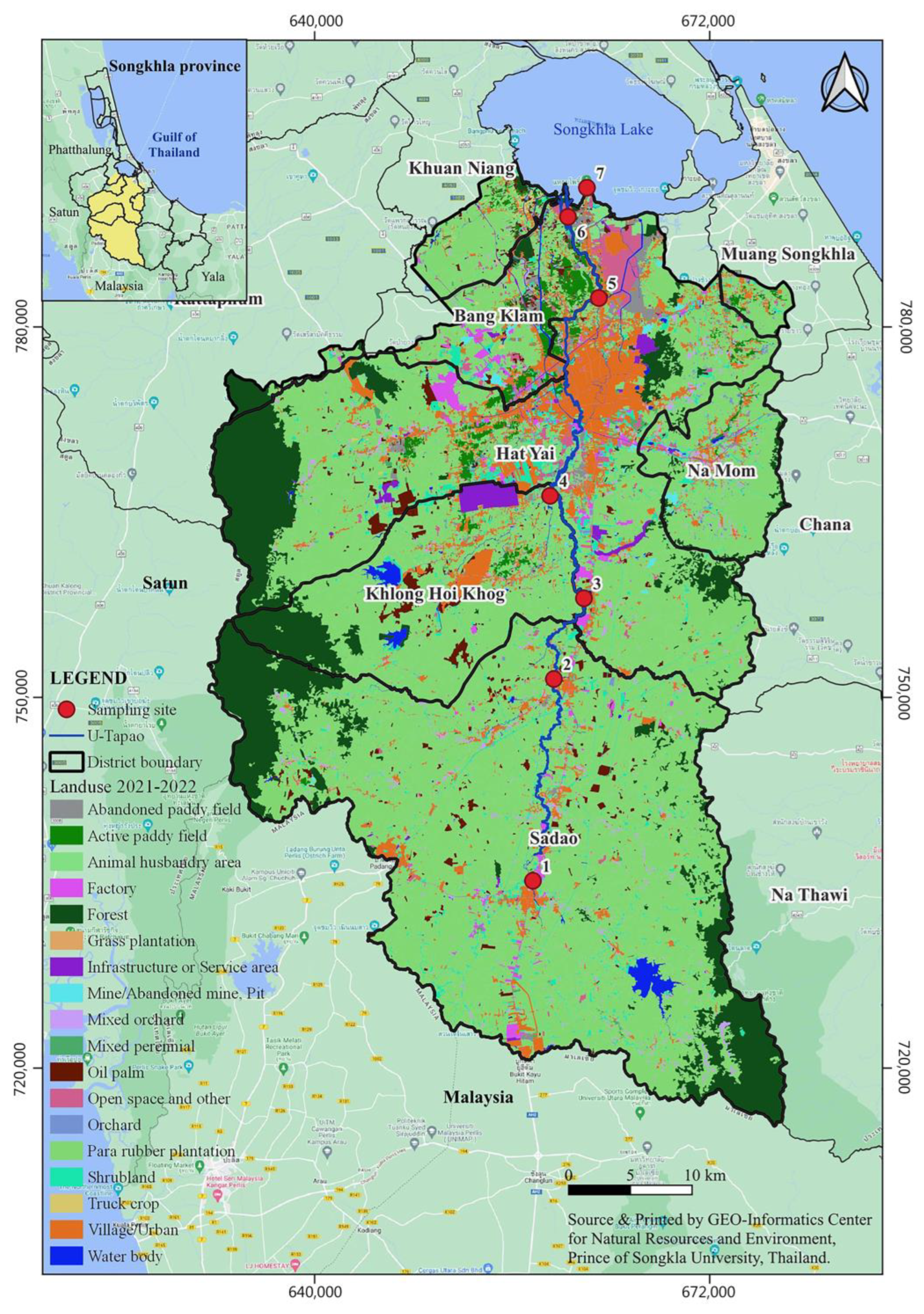

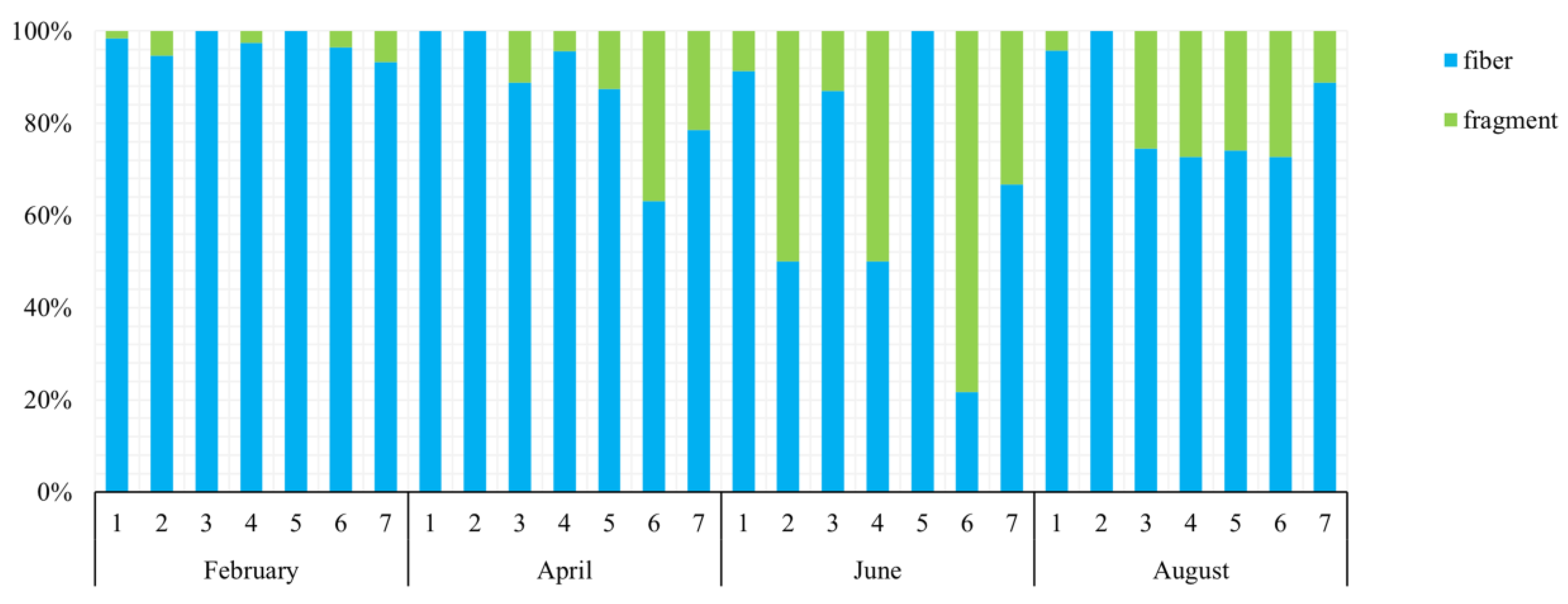
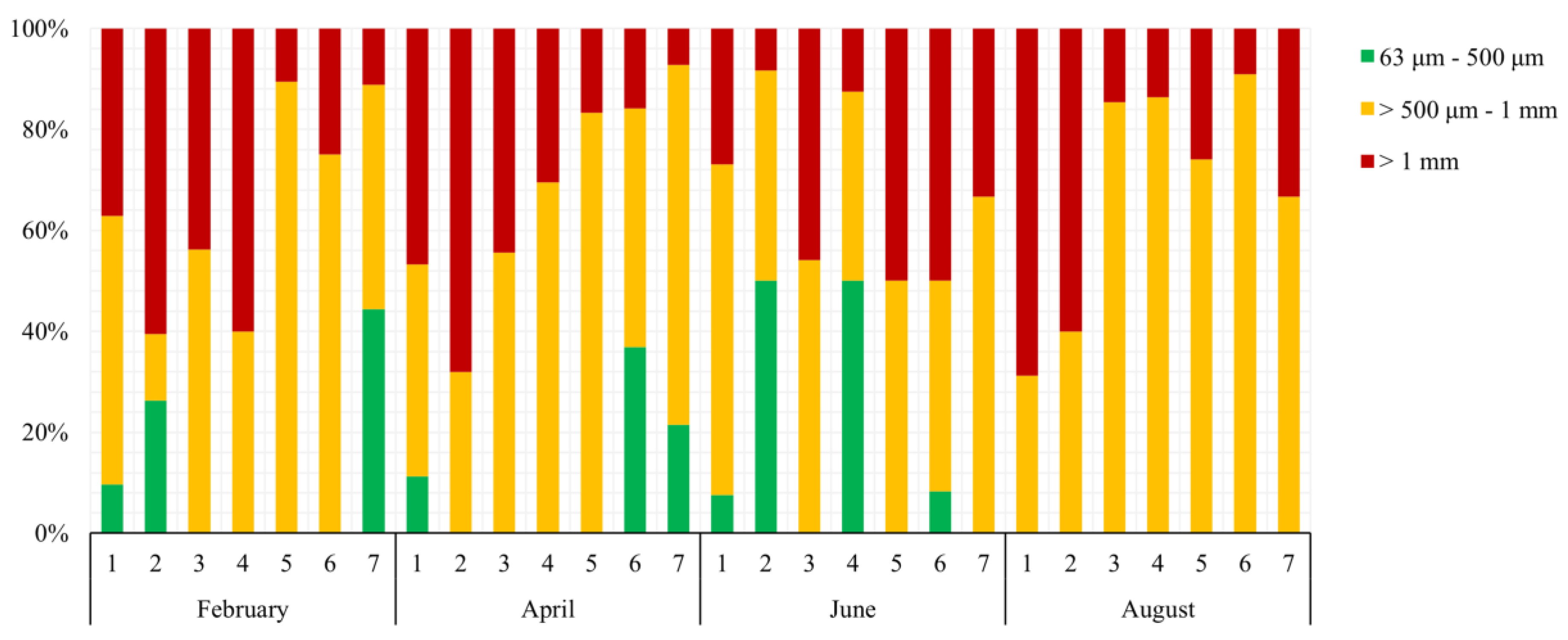
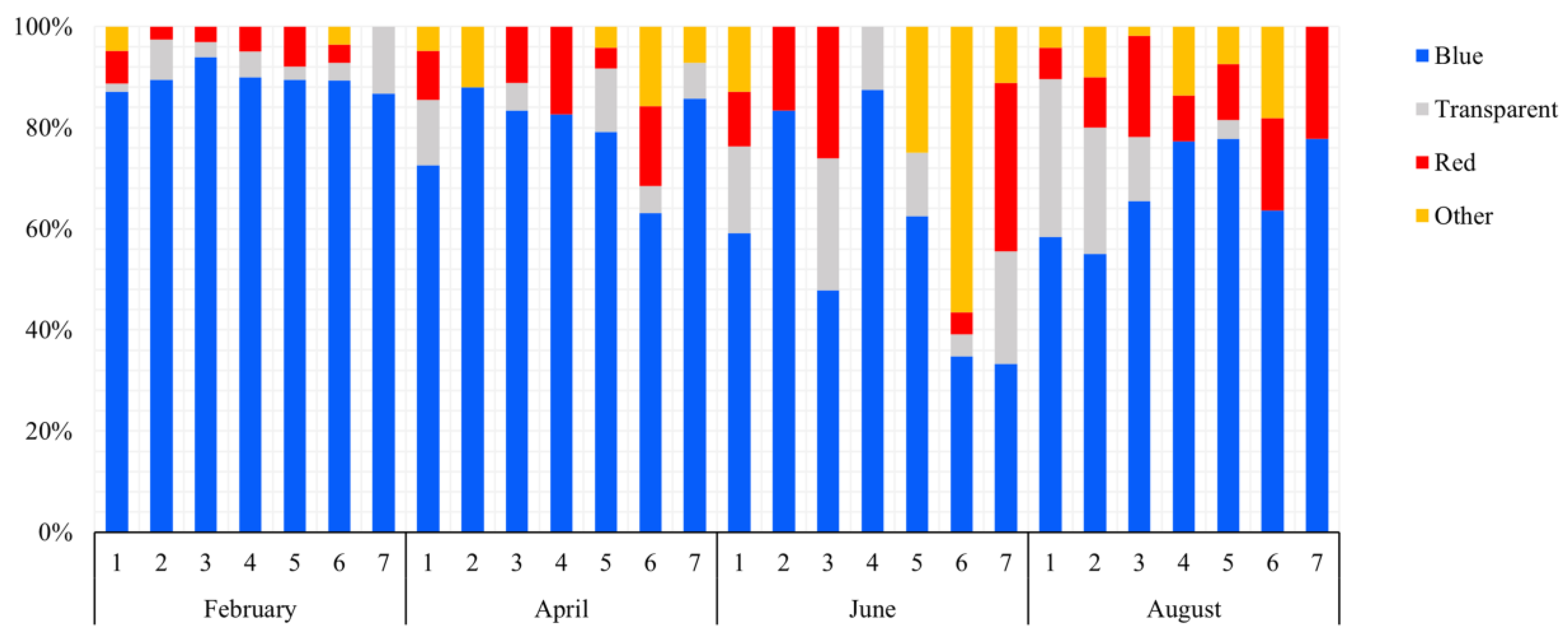
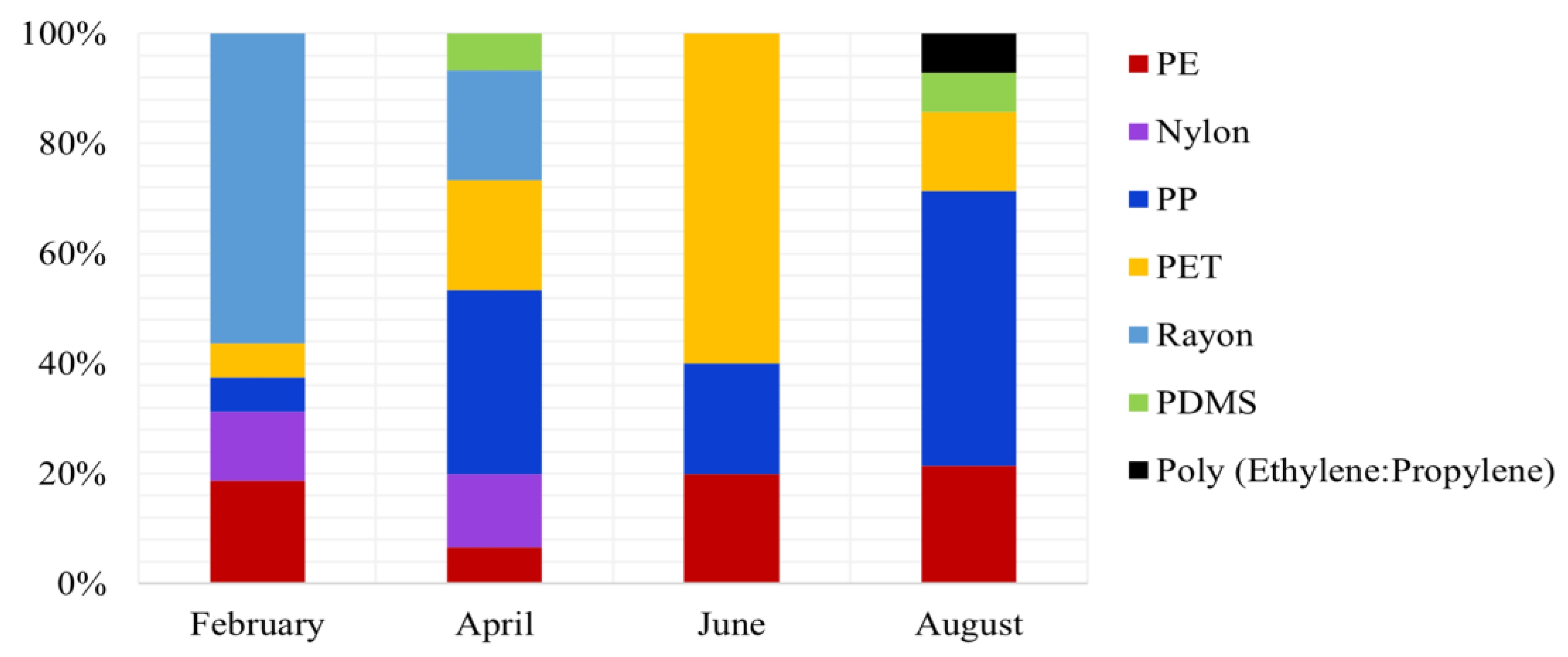
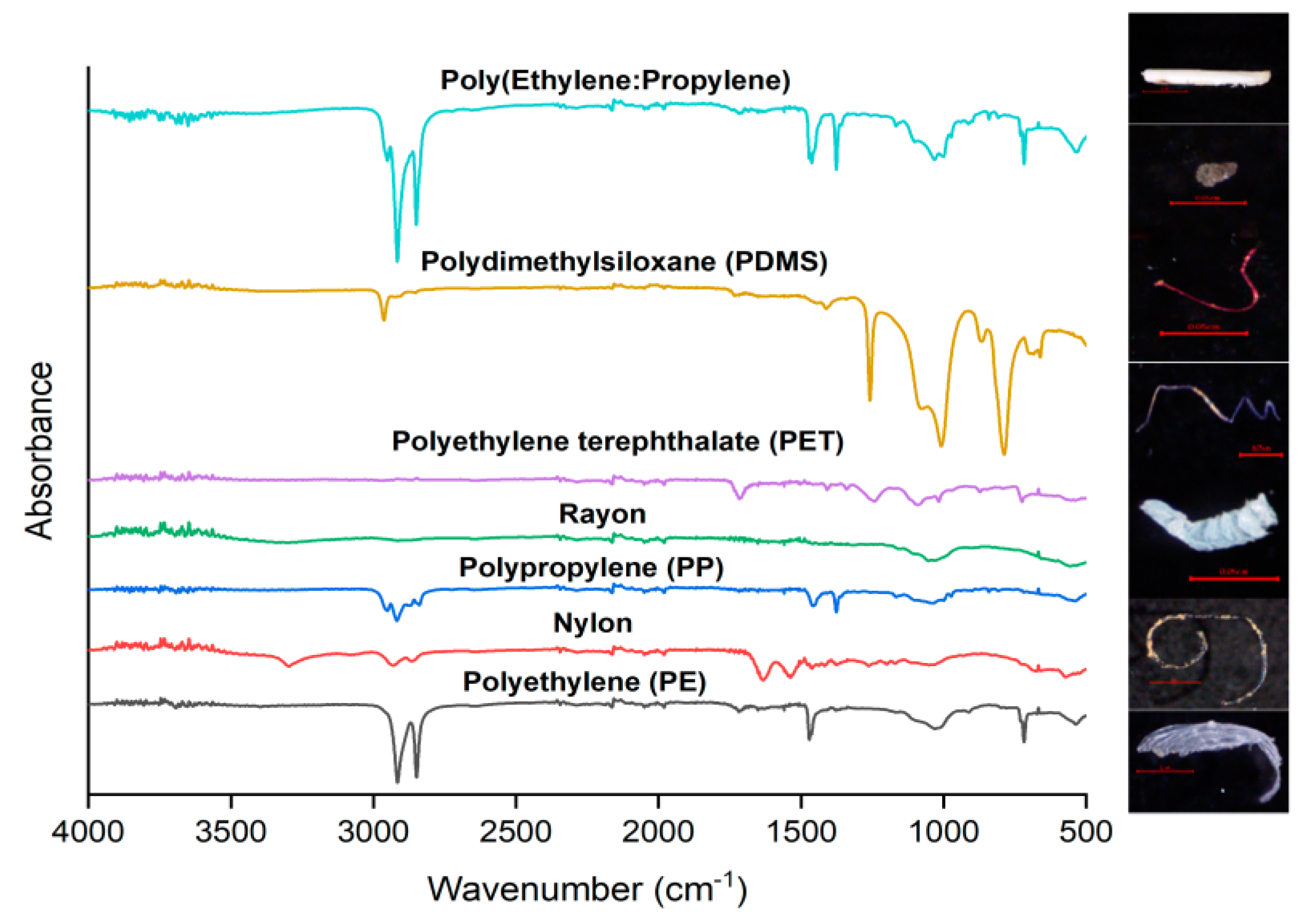
| Station | Latitude–Longitude | Description |
|---|---|---|
| 1 | 47 N 0657679, E 0735178 | Upstream |
| 2 | 47 N 0659374, E 0751493 | Upstream |
| 3 | 47 N 0661806, E 0758027 | Upstream |
| 4 | 47 N 0659067, E 0766325 | Midstream |
| 5 | 47 N 0663018, E 0782344 | Downstream |
| 6 | 47 N 0660512, E 0788918 | Downstream |
| 7 | 47 N 0662050, E 0791279 | Downstream |
| Polymer | February | April | June | August |
|---|---|---|---|---|
| PE | ✓ | ✓ | ✓ | ✓ |
| Nylon | ✓ | ✓ | ✕ | ✕ |
| PP | ✓ | ✓ | ✓ | ✓ |
| PET | ✓ | ✓ | ✓ | ✓ |
| Rayon | ✓ | ✓ | ✕ | ✕ |
| PDMS | ✕ | ✓ | ✕ | ✓ |
| Poly (ethylene:propylene) | ✕ | ✕ | ✕ | ✓ |
| Frequency | 5 | 6 | 3 | 5 |
| Location | Abundance | Shape of MPs | Reference |
|---|---|---|---|
| Tapi-Phumduang River, Thailand | 0.68–2.81 particles/5 L | Fibers | [18] |
| Saen Saeb Canal, Thailand | 370 ± 140 particles/m3 | Films, fibers | [36] |
| Chao Phraya River, Thailand | 21 ± 16 particles/m3 | Fragments or sheets/films | [37] |
| Chao Phraya River, Thailand | 104 particles/m3 | Fragments | [38] |
| Karnafull River, Bangladesh | 0.57 ± 0.07 to 6.63 ± 0.52 particles/L | Fibers | [39] |
| Rivers in Sungai Dungun, Malaysia | 22.8–300.8 particles/m3 | Fibers | [40] |
| Rivers in Nwangele, Nigeria | 440–1556 particles/L | Fragments | [41] |
| Wei River, China | 3.67–10.7 particles/L | Fibers | [42] |
| Nakdong River, South Korea | 293 ± 83 particles/m3 and 4760 ± 5242 particles/m3 | Fragments and fibers | [43] |
| Ganga River, India | 380–684 particles/1000 m3 and 143–340 particles/1000 m3 | Films | [46] |
| Fengshan River, Taiwan | 334–1058 particles/m3 | Fibers | [47] |
| Hudson River, USA | 0.98 particles/L | Fibers | [48] |
| Yangtze River, China | 0.9 particles/m3 | Sheets and fragments | [49] |
| Rivers in Tibet Plateau, China | 483–967 particles/m3 | Fibers | [50] |
| Mississippi River, USA | 14–83 particles/L | Fragments | [51] |
| Ciwalengke River, Indonesia | 5.85 ± 3.28 particles/L | Fibers | [52] |
| Taltow Canal, Germany | 0.01–95.8 particles/2.2 L | Fragments | [53] |
| Chishui River, China | 1.77–14.33 particles/L | Fibers | [54] |
| U-Taphao River, Thailand | 0.24 ± 0.11 to 0.41 ± 0.08 particles/L | Fibers and fragments | This study |
Disclaimer/Publisher’s Note: The statements, opinions and data contained in all publications are solely those of the individual author(s) and contributor(s) and not of MDPI and/or the editor(s). MDPI and/or the editor(s) disclaim responsibility for any injury to people or property resulting from any ideas, methods, instructions or products referred to in the content. |
© 2023 by the authors. Licensee MDPI, Basel, Switzerland. This article is an open access article distributed under the terms and conditions of the Creative Commons Attribution (CC BY) license (https://creativecommons.org/licenses/by/4.0/).
Share and Cite
Pradit, S.; Noppradit, P.; Sengloyluan, K.; Suwanno, P.; Tanrattanakul, V.; Sornplang, K.; Nuthammachot, N.; Jitkaew, P.; Nitiratsuwan, T. Occurrence of Microplastics in River Water in Southern Thailand. J. Mar. Sci. Eng. 2023, 11, 90. https://doi.org/10.3390/jmse11010090
Pradit S, Noppradit P, Sengloyluan K, Suwanno P, Tanrattanakul V, Sornplang K, Nuthammachot N, Jitkaew P, Nitiratsuwan T. Occurrence of Microplastics in River Water in Southern Thailand. Journal of Marine Science and Engineering. 2023; 11(1):90. https://doi.org/10.3390/jmse11010090
Chicago/Turabian StylePradit, Siriporn, Prakrit Noppradit, Karnda Sengloyluan, Phudith Suwanno, Varaporn Tanrattanakul, Kittiwara Sornplang, Narissara Nuthammachot, Preyanuch Jitkaew, and Thongchai Nitiratsuwan. 2023. "Occurrence of Microplastics in River Water in Southern Thailand" Journal of Marine Science and Engineering 11, no. 1: 90. https://doi.org/10.3390/jmse11010090
APA StylePradit, S., Noppradit, P., Sengloyluan, K., Suwanno, P., Tanrattanakul, V., Sornplang, K., Nuthammachot, N., Jitkaew, P., & Nitiratsuwan, T. (2023). Occurrence of Microplastics in River Water in Southern Thailand. Journal of Marine Science and Engineering, 11(1), 90. https://doi.org/10.3390/jmse11010090









